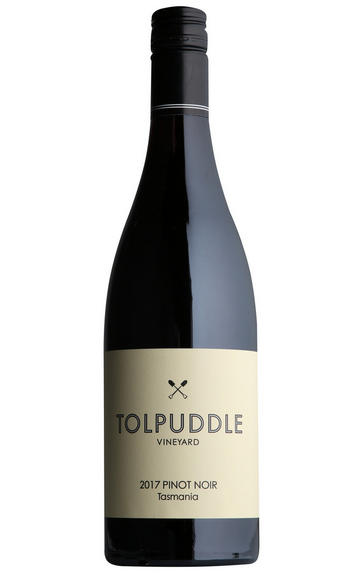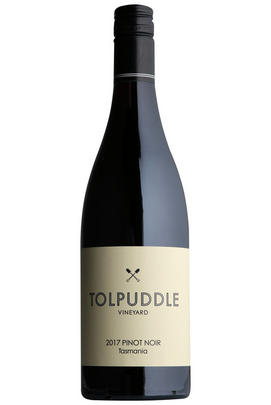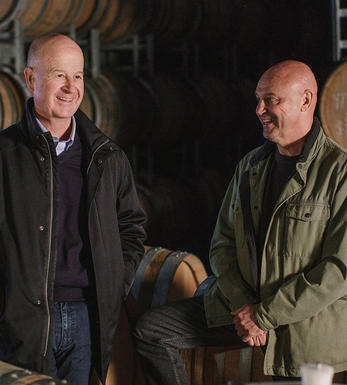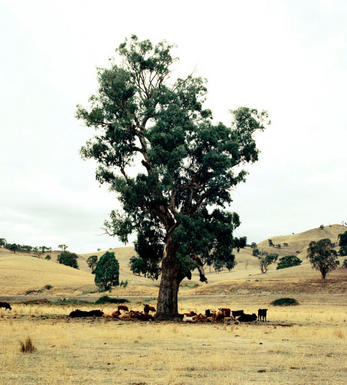
2021 Tolpuddle Vineyard, Pinot Noir, Coal River Valley, Tasmania, Australia

Critics reviews
A longer, cooler vintage has allowed the sum of all the distinctive site components to marry in ideal balance. It’s all there - pretty aromatics; plush, rounded fruit flavours with some stalky grip adding play to the texture, and a cloak of minerality providing an intriguing counterpoint as fine tannins grip at the finish. It’s alluring, enticing you back to keep reading its complexity.
Drink 2022 - 2035
David Sly, Decanter.com (September 2022)
About this WINE

Tolpuddle Vineyard
It is not bold to say Tasmania produces incredible wine, maximising the cooler, sunny climate, and a great deal of expertise. Tolpuddle is a great proponent of Tasmania viticulture, producing world-class Chardonnay and Pinot Noir.
Tolpuddle Vineyard was established in 1988 before a later purchase by two titans of Australian winemaking (and cousins), Martin Shaw and Michael Hill Smith AM MW and takes its name from the Tolpuddle Martyrs: English convicts transported to Tasmania for forming an agricultural union. The leader of the Martyrs, George Loveless, served some of his sentence working on a property near Richmond, part of which is now Tolpuddle Vineyard.
First commercially released in 2013, Tolpuddle has gone from strength to strength and is now widely recognised as amongst the very best in Australia.

Tasmania
Tasmania is better known as Australia’s ‘freezer’ on account of its cool climate. Wines were momentarily made there in 1826 before re-emerging in the 1960s and 1970s with plantings near Launceston and Hobart; 1974 saw the famous Pipers Brook area put on the map by Dr Andrew Pirie. Since 1994, the small industry (approximately 1,000 hectares) has developed as the corporates have taken a renewed interest in the quality of its Chardonnay and Pinot Noir, particularly sparkling wines. Increasingly, some of the 250 growers are, as Tasmania’s climate warms up, beginning to bottle their own wines.
The region (Tasmania being viewed as a single wine zone) is spread over two distinct, if not officially recognised, sub-regions: the cooler, north-eastern zone around Launceston, focused on the Tamar River Valley and Pipers Brook area, and the warmer southern zone around the Derwent River Valley, north-west of Hobart.
Pipers Brook is the coolest spot due to the icy influence of the Bass Strait, its north-eastern location at the island’s tip at 120 metres above sea level, and exposure to the Roaring Forties winds. Further west the weather is warmer, lower (80 metres above sea level) and more humid around Launceston; typically the harvest there is two weeks ahead of Pipers Brook. The southern, Derwent area is warmer still, on account of its low-lying (60m) shelter from the prevailing winds and rain. The soils vary from the deep, iron-rich, gravely clay in the north to the thinner, sandstone-based soils of the south.
Pinot Noir is increasingly grown to make fine, suave table wines, rather than simply as a sparkling constituent along with Chardonnay. Given the island’s southerly latitude, UV levels are similar to New Zealand’s’s, giving deep colours and pungent aromatics, especially for the up-and-coming Rieslings. Cabernet Sauvignon is found in the south, if a marginal variety.
Recommended producers: Stoney Rise, Apsley Gorge and Domaine A are top-class producers. Jansz is a reliable source of sparkling wines.

Pinot Noir
Pinot Noir is probably the most frustrating, and at times infuriating, wine grape in the world. However when it is successful, it can produce some of the most sublime wines known to man. This thin-skinned grape which grows in small, tight bunches performs well on well-drained, deepish limestone based subsoils as are found on Burgundy's Côte d'Or.
Pinot Noir is more susceptible than other varieties to over cropping - concentration and varietal character disappear rapidly if yields are excessive and yields as little as 25hl/ha are the norm for some climats of the Côte d`Or.
Because of the thinness of the skins, Pinot Noir wines are lighter in colour, body and tannins. However the best wines have grip, complexity and an intensity of fruit seldom found in wine from other grapes. Young Pinot Noir can smell almost sweet, redolent with freshly crushed raspberries, cherries and redcurrants. When mature, the best wines develop a sensuous, silky mouth feel with the fruit flavours deepening and gamey "sous-bois" nuances emerging.
The best examples are still found in Burgundy, although Pinot Noir`s key role in Champagne should not be forgotten. It is grown throughout the world with notable success in the Carneros and Russian River Valley districts of California, and the Martinborough and Central Otago regions of New Zealand.


Buying options
Add to wishlist
Description
A longer, cooler vintage has allowed the sum of all the distinctive site components to marry in ideal balance. It’s all there - pretty aromatics; plush, rounded fruit flavours with some stalky grip adding play to the texture, and a cloak of minerality providing an intriguing counterpoint as fine tannins grip at the finish. It’s alluring, enticing you back to keep reading its complexity.
Drink 2022 - 2035
David Sly, Decanter.com (September 2022)
wine at a glance
Delivery and quality guarantee